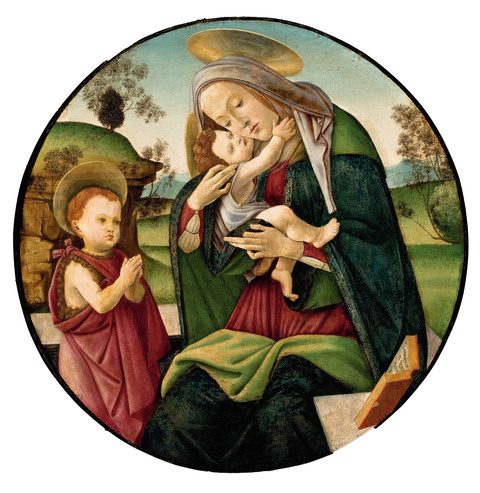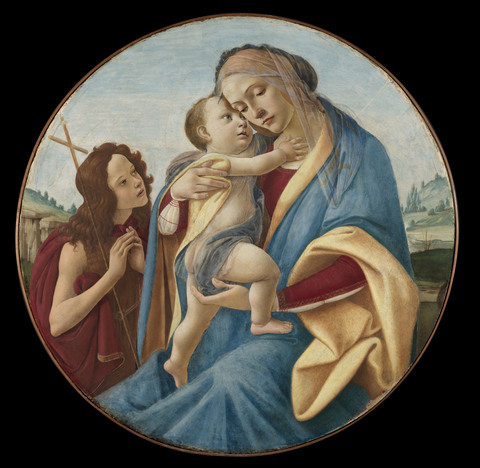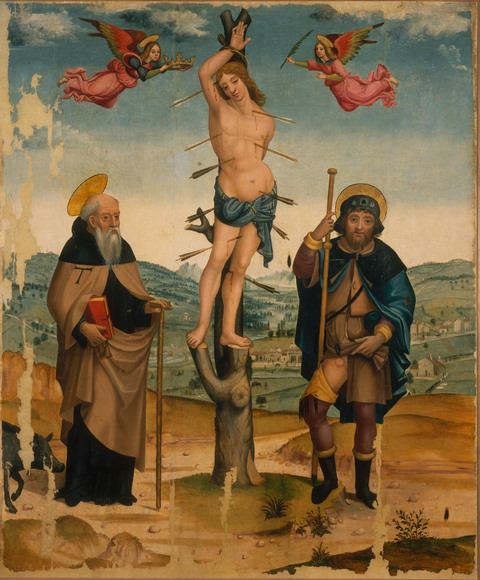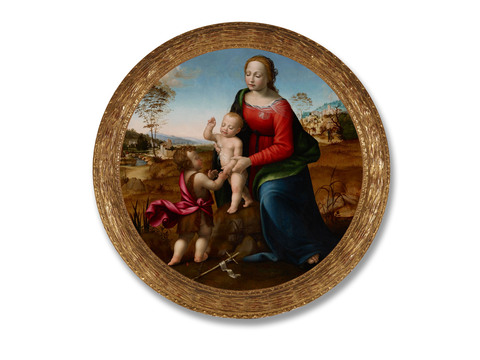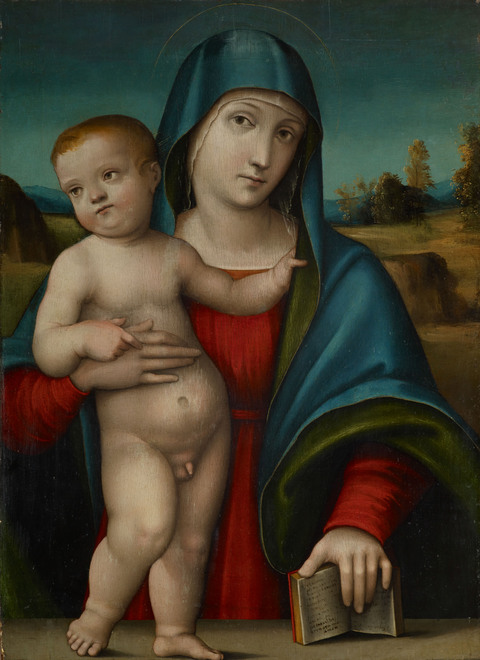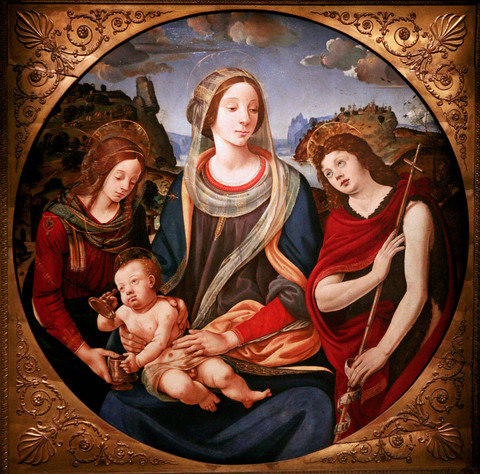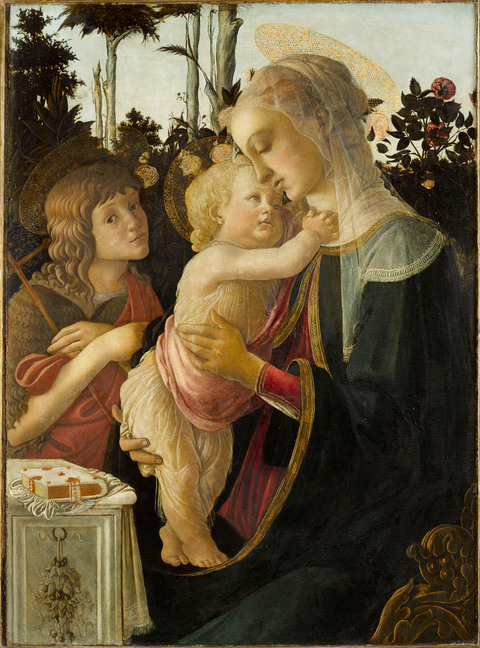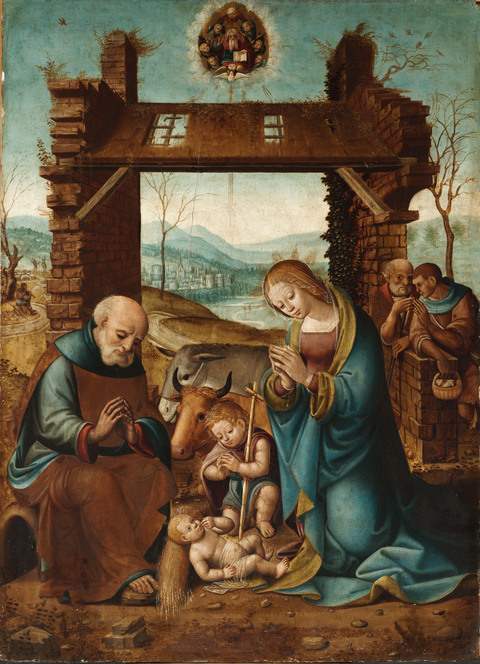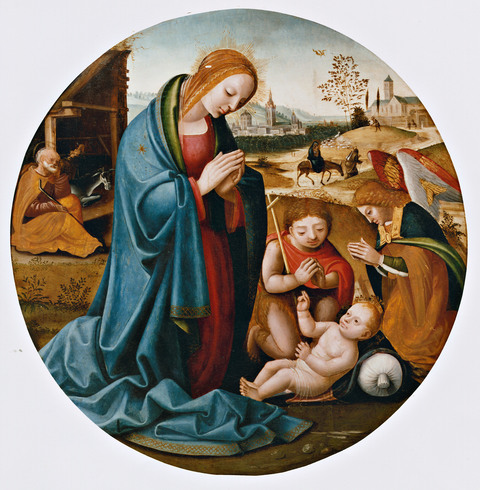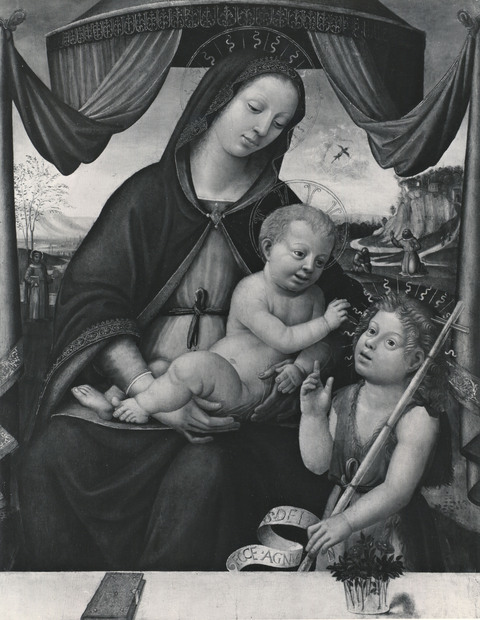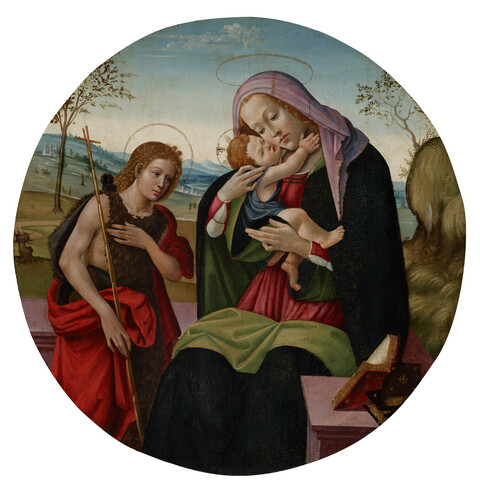Marks, Inscriptions, and Distinguishing Features
None
Entry
Madonna and Child with St. John the Baptist, the first major acquisition for what would become the Clowes Collection, is a lovely example of early Cinquecento painting. The circular-shaped composition, known in Italian as a tondo, was clearly influenced by the work of late fifteenth-century Florentine artists, particularly that of Sandro Botticelli (1444/1445–1510). At the time of its purchase in 1933, the work was attributed to the Italian artist Piero di Cosimo (1462–1521). This identification, certified by the Dutch art historian Raimond van Marle for E. and A. Silberman Galleries of New York, is no longer accepted. Following this, the painting was ascribed to an anonymous artist in the circle of Botticelli. However, now the tondo is believed to be the work of the Master of the Campana Panels, a French artist who worked in Florence during the early sixteenth century. The paintings attributed to this artist contain allusions to the work of Filippino Lippi (about 1457–1504), Piero di Cosimo, and Sandro Botticelli, situating their creation within the milieu of Florence. The current attribution was first put forth by Christopher Daly in 2013 and was promoted by the late Everett Fahy. More recently, Dr. Louis A. Waldman and Luca Mattedi supported this suggestion, while also acknowledging that the Clowes tondo was influenced by Botticelli’s reinterpretation of the Byzantine Panagia Glykophilousa (loving Virgin) icon.
Sandro Botticelli, born Alessandro di Mariano Filipepi, rose to prominence during the early modern period in Florence, Italy. His style, which emphasized graceful contours, movement, and an attenuated figural type, resonated with the de facto ruler of the city, Lorenzo “the Magnificent” de' Medici (1449–1492), and other Florentine elites. According to the biographer Giorgio Vasari (1511–1574), the young artist apprenticed under Fra Filippo Lippi (1406–1469). Lippi’s influence is evident in Botticelli’s linear handling of the body and his numerous half-length paintings of the Madonna and Child, a compositional format he borrowed from the older artist. Botticelli’s work also reveals his familiarity with the work of Antonio del Pollaiuolo (1433–1498), Andrea del Verrocchio (1435–1488), and Domenico Ghirlandaio (1449–1494), all of whom ran prominent botteghe in Florence. By 1470, Botticelli’s own busy workshop operated alongside those masters, steadily producing half-length Madonna and Child paintings and mythological scenes for the humanist court of Lorenzo the Magnificent.
The attribution of the Clowes painting to the Master of the Campana Panels, an artist who closely observed the work of Botticelli, is based on a stylistic analysis of the composition. The tondo is a conflation of several of Botticelli’s paintings, including
Virgin and Child with the Infant St. John the Baptist (fig. 1);
Madonna and Child with Saint John the Baptist and an Angel (fig. 2); and
Virgin and Child with the Young St. John the Baptist (fig. 3).
Despite the Clowes painting’s correspondences to these compositions, the earlier attribution to Piero di Cosimo is understandable as the tondo’s landscape appears, at a cursory glance, to contain the unique shrubbery characteristic of the older artist’s work. However, a more careful study reveals that the background of the Clowes painting lacks Piero’s detail. In particular, the distant buildings and the horse and rider behind the young saint are rendered in a perfunctory manner that is at odds with Piero’s acknowledged relish for representing seemingly insignificant objects, but which is akin to the backgrounds of several paintings attributed to the Master of the Campana Panels. A similar lack of details is visible in the latter artist’s
Saint Sebastian with Saints Anthony Abbot and Roch (fig. 4) and
Cymon and Iphigenia (fig. 5).
Figure 1: Sandro Botticelli (Italian, 1444/1445–1510), Virgin and Child with the Infant St. John the Baptist, about 1490–1500, tempera on wood, 29-23/632 (diam.) in. São Paulo Museum of Art, Brazil, Gift of Dona Sinhá Junqueira, 1947, MASP.00009. Photo: João Musa.
Figure 1: Sandro Botticelli (Italian, 1444/1445–1510), Virgin and Child with the Infant St. John the Baptist, about 1490–1500, tempera on wood, 29-23/632 (diam.) in. São Paulo Museum of Art, Brazil, Gift of Dona Sinhá Junqueira, 1947, MASP.00009. Photo: João Musa.
Figure 2: Sandro Botticelli (Italian, 1444/1445–1510), Madonna and Child with Saint John the Baptist and an Angel, about 1485, tempera and oil on poplar panel, 34-7/16 in. (diameter). Private Collection, USA. Photo credit: Rapp Halour / Alamy Stock Photo.
Figure 2: Sandro Botticelli (Italian, 1444/1445–1510), Madonna and Child with Saint John the Baptist and an Angel, about 1485, tempera and oil on poplar panel, 34-7/16 in. (diameter). Private Collection, USA. Photo credit: Rapp Halour / Alamy Stock Photo.
Figure 3: Sandro Botticelli (Italian, 1444/1445–1510) and Workshop, Virgin and Child with the Young St. John the Baptist, about 1490, tempera and oil on wood, 26-3/4 (diam.) in., 45-1/4 × 4-15/16 in. (framed). Cleveland Museum of Art, Ohio, Leonard C. Hanna, Jr. Fund, 1970.160.
Figure 3: Sandro Botticelli (Italian, 1444/1445–1510) and Workshop, Virgin and Child with the Young St. John the Baptist, about 1490, tempera and oil on wood, 26-3/4 (diam.) in., 45-1/4 × 4-15/16 in. (framed). Cleveland Museum of Art, Ohio, Leonard C. Hanna, Jr. Fund, 1970.160.
Figure 4: Master of the Campana Panels (Italian, active in Florence), Saint Sebastian with Saints Anthony Abbot and Roch, oil on wood panel, 58-1/4 × 46-1/16 in. Museo Giuliano Ghelli, San Casciano, Val di Pesa, Tuscany, Italy. Photo: Scala / Art Resource, NY.
Figure 4: Master of the Campana Panels (Italian, active in Florence), Saint Sebastian with Saints Anthony Abbot and Roch, oil on wood panel, 58-1/4 × 46-1/16 in. Museo Giuliano Ghelli, San Casciano, Val di Pesa, Tuscany, Italy. Photo: Scala / Art Resource, NY.
Figure 5: Master of the Campana Panels (Italian, active in Florence), Cymon and Iphigenia, tempera on wood panel, 22-3/4 × 66-3/4 in. Current location unknown. Photo © Christie’s Images/Bridgeman Images.
Figure 5: Master of the Campana Panels (Italian, active in Florence), Cymon and Iphigenia, tempera on wood panel, 22-3/4 × 66-3/4 in. Current location unknown. Photo © Christie’s Images/Bridgeman Images.
In the Clowes painting, Mary is seated on a low parapet, tenderly supporting her child. The mother and son embrace cheek to cheek as the infant Christ extends his right arm upward to caresses her face. The young St. John the Baptist, who stands to the proper right of the holy pair, witnesses this familial exchange of affection and touches his chest in respect and acknowledgment that before him is the savior of humankind. A small ledge or table to the viewer’s right holds several prayer books, one of which, in a gold-tooled red cover, is open and propped upright, as though the holy mother’s study was just interrupted by her son’s caress. The reference to prayer manuals was not coincidental. Often such books were depicted so that the partial text of the Magnificat, which is associated with Mary, was legible. This supplication, similar to several other medieval and Renaissance prayers, was intended to be recited in the evening. Thus, the patron of Madonna and Child with St. John the Baptist would likely have retired shortly after quietly observing devotions before this painting, which may have hung in a finely appointed bedroom. Placing images of young saints in the bedroom—ultimately the birthing room—reassured expecting women and new mothers, both of whom feared the high infant mortality rate.
The artist’s use of aerial perspective leads the viewer’s eye back to the two mountains in the distance, to the left of the infant Christ’s head. Upon noting these peaks, the viewer observes other pairings within the composition: three couples to the left of the Madonna, two spindly trees to either side of the holy figures, and the intriguing partial tuck of the ring finger underneath the middle finger on both hands of Mary and St. John the Baptist. This gesture is exhibited in several Florentine paintings: Botticelli’s allegorical figure in Fortitude (1470; Florence, Galleria degli Uffizi) and Piero di Cosimo’s Virgin Mary in the Madonna and Sleeping Christ Child with the Infant Saint John the Baptist (ND, Private Collection) are but two examples that feature this motif. The inclusion of this gesture in the Clowes painting signals that the artist made a careful study of, and had an appreciation for, the compositions of Tuscan artists.
While the palette of the Clowes painting does not provide any clues to confirm the identity of its creator, the jeweled hues do reflect the color schema popular with Florentine artists of the period. In particular, the Madonna’s mantle, which is lined in green, recalls Botticelli’s
Virgin and Child with the Infant St. John the Baptist, Giuliano Bugiadini’s
Madonna and Child with the Infant Saint John the Baptist (fig. 6), and
Giulio Francia’s Madonna and Child (fig. 7).
These compositions, along with the Clowes tondo, employ the green lining as a contrast to the deep crimson of the Virgin’s gown and the mantle of the young St. John. Likewise, the headdress of the Madonna in Piero di Cosimo’s
Madonna and Child with Saints Mary Magdalene and John the Baptist (fig. 8), and that in the Clowes panel are comparable; each is striped with gold, although the former is more diaphanous. In the Clowes painting, the mauve-colored parapet and table serve as a visual bridge, linking the blue garment of the Christ child and the blue shadow on the Virgin’s lavender veil to the blue of the horizon.
Figure 6: Giuliano Bugiardini (Italian, 1475–1554), Madonna and Child with the Infant Saint John the Baptist, about 1518–1520, oil on panel, 34-1/4 (diam.) in. Indianapolis Museum of Art at Newfields, Gift of Mr. and Mrs. William H. Ball, 79.1133.
Figure 6: Giuliano Bugiardini (Italian, 1475–1554), Madonna and Child with the Infant Saint John the Baptist, about 1518–1520, oil on panel, 34-1/4 (diam.) in. Indianapolis Museum of Art at Newfields, Gift of Mr. and Mrs. William H. Ball, 79.1133.
Figure 7: Giulio Francia, Madonna and Child, about 1515, oil on poplar panel, 24-13/16 x 18-7/16 in. The Clowes Collection, Indianapolis Museum of Art at Newfields, 2017.90.
Figure 7: Giulio Francia, Madonna and Child, about 1515, oil on poplar panel, 24-13/16 x 18-7/16 in. The Clowes Collection, Indianapolis Museum of Art at Newfields, 2017.90.
Figure 8: Piero di Cosimo (Italian, 1462–1521), Madonna and Child with Saints Mary Magdalene and John the Baptist, about 1480, oil on wood panel, 37-19/21 (diam.) in. (panel), 45-9/32 (diam.). in. (framed). Musée des Beaux-Arts, Strasbourg, 44.981.1.1. Photo credit © Photographic service of the Museums of Strasbourg, © PLISSON.
Figure 8: Piero di Cosimo (Italian, 1462–1521), Madonna and Child with Saints Mary Magdalene and John the Baptist, about 1480, oil on wood panel, 37-19/21 (diam.) in. (panel), 45-9/32 (diam.). in. (framed). Musée des Beaux-Arts, Strasbourg, 44.981.1.1. Photo credit © Photographic service of the Museums of Strasbourg, © PLISSON.
While the palette is typical of a Florentine artist in Botticelli’s circle, the execution of the Clowes tondo is different from those of the Italian master. As noted by Daly, Botticelli was partial to tempera paint until late in his career, and his application of oil paint, when finally adopted, was typically thicker than that witnessed on the Clowes panel. Additionally, Botticelli’s highlights commonly were formed with thick white paint. In contrast, the oil paint on the Clowes Panel is applied in thin layers, which is characteristic of the paintings attributed to the Master of the Campana Panels.
The decision by the Master of the Campana Panels to portray St. John as prepubescent, rather than as a toddler or an adult, is in keeping with other Florentine representations of this saint during this era. Saint John the Baptist was the patron saint of the city, and depictions of the saint as a boy were therefore deemed appropriate devotional images for the young males of Florence.
Botticelli’s
Madonna and Child with the Infant St. John the Baptist (fig. 9) also portrays the saint not as an infant but as a young boy.
This painting is not circular, but the figure of St. John is comparable in attire and attribute to the one in the Clowes tondo; both are shown as young boys garbed in brown hair shirts with crimson mantels, and both carry reed crosses. Moreover, the proper left hand of the Clowes St. John, which extends across his chest and rests lightly against his breast, is too similar to the gesture of Botticelli’s saint to have derived from another source. Although other Renaissance paintings, including several by Leonardo da Vinci, portrayed St. John as a young boy, Botticelli’s interpretation with this gesture predates most renditions. Thus, Piero di Cosimo’s abovementioned
Madonna and Child with Saints Mary Magdalene and John the Baptist that features the saint as a youth likely was influenced by Botticelli’s earlier painting.
Figure 9: Sandro Botticelli (Italian, 1444/1445–1510), Madonna and Child with the Infant Saint John the Baptist, about 1450–1475, tempera on wood, 35-45/64 × 26-3/8 in. Musée du Louvre, Paris, Inv. 286. Photo © 2015 RMN-Grand Palais (Louvre Museum) / Tony Querrec.
Figure 9: Sandro Botticelli (Italian, 1444/1445–1510), Madonna and Child with the Infant Saint John the Baptist, about 1450–1475, tempera on wood, 35-45/64 × 26-3/8 in. Musée du Louvre, Paris, Inv. 286. Photo © 2015 RMN-Grand Palais (Louvre Museum) / Tony Querrec.
A comparison of the
Nativity with the Infant Saint John the Baptist (fig. 10) by the Master of the Campana Panels in Harvard’s Fogg Museum and the Clowes painting illuminates several stylistic affinities and correspondences. The Master of the Campana Panels’s figures frequently exhibit high arched eyebrows and noses that lack an indentation between the forehead and the slope, which results in a contoured wedge that connects to the upward-raised brows. These characteristics are found in the figures of the Virgin Mary and St. John the Baptist in the Fogg painting. Likewise, the three figures in the Clowes work display equally arched brows, and the noses of the Madonna and the young Baptist are comparable to those in the Fogg panel, the
Adoration of the Christ Child with the Infant St. John and an Angel (fig. 11), and the
Madonna and Child with the Young St. John (fig. 12), all of which are given to the Master of the Campana Panels
. Figure 10: Master of the Campana Panels (Italian, active in Florence), Previously attributed to Master of Tavernelle (Italian, 1480–1510), The Nativity with the Infant Saint John the Baptist, early 16th century, oil on panel, 32 × 22-3/4 in. Harvard Art Museums/Fogg Museum, Bequest of Lucy Wallace Porter, 1962.288. Photo © President and Fellows of Harvard College.
Figure 10: Master of the Campana Panels (Italian, active in Florence), Previously attributed to Master of Tavernelle (Italian, 1480–1510), The Nativity with the Infant Saint John the Baptist, early 16th century, oil on panel, 32 × 22-3/4 in. Harvard Art Museums/Fogg Museum, Bequest of Lucy Wallace Porter, 1962.288. Photo © President and Fellows of Harvard College.
Figure 11: Master of the Campana Panels (Italian, active in Florence), Adoration of the Christ Child with the Infant St. John and an Angel, about 1500–1525, oil on canvas, 34-1/4 (diam.). Mercato antiquario, Florence. Photo Courtesy Fondazione Federico Zeri, Università di Bologna, Zeri Photo Library, 36125.
Figure 11: Master of the Campana Panels (Italian, active in Florence), Adoration of the Christ Child with the Infant St. John and an Angel, about 1500–1525, oil on canvas, 34-1/4 (diam.). Mercato antiquario, Florence. Photo Courtesy Fondazione Federico Zeri, Università di Bologna, Zeri Photo Library, 36125.
Figure 12: Master of the Campana Panels (Italian, active in Florence), Madonna and Child with the Young St. John, about 1500–1525, 38-3/16 × 28-11/32 in. Gerini Collection, Florence. Photo Courtesy Fondazione Federico Zeri, Università di Bologna, Zeri Photo Library, 58088.
Figure 12: Master of the Campana Panels (Italian, active in Florence), Madonna and Child with the Young St. John, about 1500–1525, 38-3/16 × 28-11/32 in. Gerini Collection, Florence. Photo Courtesy Fondazione Federico Zeri, Università di Bologna, Zeri Photo Library, 58088.
The youthful St. John in the Clowes painting features the strange placement and design of the ear as that of the same saint in the Fogg’s Nativity with the Infant Saint John the Baptist. This anatomically incorrect rendering is commonly found in figures by the Master of the Campana Panels. Additionally, the skullcap or incised hairstyle of the Christ child, is nearly identical in each of the Master of the Campana Panels’s religious compositions. Moreover, the source of the unusual forehead curls seen on the Clowes St. John the Baptist is located in the previously noted Adoration of the Christ Child with Infant St. John the Baptist and an Angel. The angel and the Baptist sport the same odd hairstyle, which is repeated again in the artist’s Madonna and Child with the Young St. John. Beyond these basic resemblances, the placement and design of the eyes of the Virgin Mary and the Baptist in the Clowes tondo is analogous to the treatment of these features in paintings firmly ascribed to the Master of the Campana Panels.
Additional correspondences in style between the Clowes Madonna and Child with St. John the Baptist and other compositions by the Master of the Campana Panels can be detected in the backgrounds. In the painter’s Nativity with the Infant Saint John the Baptist, the Trinity with St. Rocco and St. Lucia (Church of Santa Maria Assunta, Petrazzi, Castelfiorentino) and Eurydice and Her Companions (Collection of C. De Nora, Geneva, Switzerland), the viewer recognizes the same vocabulary of sparse linear trees, aerial perspective, and fanciful ledges and tree stumps—the last of which are obviously quotations from the work of Piero di Cosimo, as seen in the background vista of the Clowes painting.
What conclusions can be reached about the Madonna and Child with St. John the Baptist and the painter who created it? Given the uneven handling of the figures and the overall lack of precise details, it is unlikely that the Clowes painting was generated in the botteghe of either Botticelli or Piero di Cosimo. Despite this, the composition’s multiple allusions to the work of both Tuscan artists suggests that it was created within the confines of Florence. Many of the city’s artists copied the compositional motifs of Botticelli and Piero di Cosimo in the late fifteenth and early sixteenth centuries, and the tondo format was particularly popular in the region at the time. A final link between the Clowes painting and the city of Florence is the inclusion of the reed cross held by the young St. John, a motif that art historian Bernard Berenson (1865–1959) noted first appeared in Florentine paintings of the late 1400s. It is probable that the Madonna and Child with St. John the Baptist was created by the French Master of the Campana Panels who worked for a time in Florence. The tondo, which reveals the influence of multiple local artists, results from the northern artist’s engagement with, and emulation of, the work of Botticelli, Piero di Cosimo, and other Florentine masters. These influences resulted in a composition that has puzzled and engaged scholars to the present day. The Madonna and Child with St. John the Baptist is an important work not due to the fame of its creator, but because it enriches the public’s understanding of artistic training, cultural exchange, and patterns of influence in the early modern period.
Author
Chrystine L. Keener
Provenance
Exported from Milan, between 1792 and 1860.
Probably Prince Tassilo Festetics de Tolna (1850–1933), Keszthely, Hungary;
(E. and A. Silberman Galleries, New York);
G.H.A. Clowes, Indianapolis, in 1933;
The Clowes Fund, Indianapolis, from 1958–2014, and on long-term loan to the Indianapolis Museum of Art since 1971 (C10029);
Given to the Indianapolis Museum of Art, now the Indianapolis Museum of Art at Newfields, in 2014 (2014.85).
Exhibitions
John Herron Art Museum, Indianapolis, IN, 1959, Paintings from the Collection of George Henry Alexander Clowes: A Memorial Exhibition;
Indiana University Museum of Art, Bloomington, IN, 1962, Italian and Spanish Paintings from the Clowes Fund Collection.
References
Paintings from the Collection of George Henry Alexander Clowes: A Memorial Exhibition, exh. cat. (Indianapolis: John Herron Art Museum, 1959), no. 23 (reproduced);
Italian and Spanish Paintings from the Clowes Fund Collection, exh. cat. (Bloomington: Indiana University Museum of Art, 1963), No. 9;
A. Ian Fraser, A Catalogue of the Clowes Collection (Indianapolis: Indianapolis Museum of Art, 1973), 16–17 (reproduced);
Ronda Kasl, Giovanni Bellini and the Art of Devotion, exh. cat. (Indianapolis: Indianapolis Museum of Art, 2005), 65;
Alte Kunst 342, sale cat., Van Ham, Cologne, November 14, 2014, no. 502, 13 (cropped reproduction).
Notes
